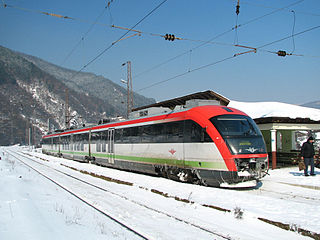
An electro-diesel locomotive is a type of locomotive that can be powered either from an electricity supply or by using the onboard diesel engine. For the most part, these locomotives are built to serve regional, niche markets with a very specific purpose.

Yugoslav Railways, with standard acronym JŽ, was the state railway company of Yugoslavia, operational from the 1920s to the 1990s, with its final incarnation transferring to Serbia. The successor of JŽ is the joint stock company of the Serbian Railways in 2006.
The Bulgarian State Railways are Bulgaria's state railway company and former largest railway carrier in the country, established as an entity in 1888. The company's headquarters are located in the capital Sofia. Since the 1990s, the BDŽ has met serious competition from automotive transport. Up to 2002 the company also owned/managed the state railway infrastructure in the country, when according to EU regulations a new state company, the National Railway Infrastructure Company, was founded and became the owner of the infrastructure.

The Mariazell Railway is an electrically operated narrow-gauge railway which connects the Lower Austrian capital of Sankt Pölten with the Styrian pilgrimage centre of Mariazell. The line was opened in stages between 1898 and 1907, and had a, now closed, branch to Wieselburg an der Erlauf. The railway is operated by NÖVOG, which is owned by the provincial government, and is a part of the Verkehrsverbund Niederösterreich-Burgenland.

Septemvri is a town in Pazardzhik Province, Southern Bulgaria, located at the western end of the Upper Thracian Lowland, 19 km (12 mi) away to the west from the city of Pazardzhik. It is the administrative centre of homonymous Septemvri Municipality. As of December 2009, the town had a population of 8,422.

Dobrinishte is a small town and ski resort in the Blagoevgrad Province, Bansko Municipality, southwestern Bulgaria. As of 2006 it had 2973 inhabitants. It is located 6 km east of Bansko, a famous winter resort. It has an altitude of 850 m and is surrounded by the Rila, Pirin, and Rhodope mountains. Dobrinishte offers good conditions for both winter and summer tourism: beautiful nature, hospitable population, ski runs, mineral waters and opportunities for rural and ecotourism. According to legends and song, between 6th and 15th century Dobrinishte was a Bulgarian stronghold which halted the Byzantines from invading the country from the valley of the Mesta River.

Rail transport in Bulgaria is an important mode of transport in Bulgaria.

The DB Class V 51 and DB Class V 52 are classes of almost identical narrow gauge 4 axle diesel hydraulic locomotives built in 1964 for the Deutsche Bundesbahn, being built for 750 mm and 1,000 mm gauge lines respectively.
Steam traction was the predominant form of motive power used by the Deutsche Reichsbahn on its narrow-gauge railways. For certain duties diesel locomotives were also used, albeit these were usually second-hand or rebuilt engines.

The Septemvri–Dobrinishte narrow-gauge line is the only operating 760 mm narrow-gauge line in Bulgaria. It is operated by Bulgarian State Railways (BDŽ). The line is actively used with four passenger trains running the length of the line in each direction per day. The journey takes five hours through the valleys and gorges between the mountain ranges of Rila, Pirin and Rhodopes.

From the 19th into the early 20th there were many 600 mm and 760 mm gauge railways in existence Bulgaria, some were dismantled and others were converted to standard gauge.
Europe inherited a diversity of rail gauges. Extensive narrow-gauge railway networks exist in Spain, Central Europe and Southeastern Europe.

In the rail transport system of Bangladesh, diesel locomotives are used by Bangladesh Railway (BR). Among diesel locos, there are diesel-electric and diesel-hydraulic locos. Besides diesel locos, steam locos were used in the past, but now they are no longer used. By gauge, there are narrow-gauge (762 mm), meter-gauge (1,000 mm) and broad-gauge (1,676 mm) locos in Bangladesh. Among them, as no narrow-gauge railroads are active, so the narrow-gauge locos are not used anymore.
After 1973 the acquisition of additional high-speed diesel locomotives was considered to complement the BDZ park for the Septemvri - Dobrinishte line and especially for the replacement of the steam tram along the line Cherven Bryag - Oryahovo. The acquisition of class 75 locomotives failed for a number of reasons. Thus a construction and supply contract was signed with the Romanian plant "23 August" - Bucharest. The locomotives were built to the technical conditions of BDZ, reflecting the experience of the already 10 years of operation of the class 75 locomotives.

The locomotives were built and delivered by the Romanian plant "23 August" - Bucharest under technical conditions of BDZ. Maximum interchangeability of aggregates, assemblies and parts with the class 76 machines, built in the same plant, was pursued. The main differences with them are:
The vehicles of the BDŽ class 05 01-03 were four-axle Diesel–mechanical railcars designed for the 760 mm narrow-gauge railways of the Bulgarian State Railways (BDŽ).

The vehicles of the BDŽ class 05 04-07 were four-axle Diesel–mechanical railcars for the 760 mm narrow-gauge railways of the Bulgarian State Railways (BDŽ).

The DR Class V 60 was a class of 0-8-0 diesel-hydraulic locomotives of the Deutsche Reichsbahn intended for medium to heavy shunting service.
CFR Series 040 DH are locomotives produced in large numbers, equipped with a hydrodynamic power transmission. They were used for shunting and light mainline service by the Romanian state railways CFR. In addition, 475 locomotives of this type were delivered to Romanian industrial companies, 263 units were delivered to Bulgaria, 42 units were delivered to industrial companies in Czechoslovakia, three units went to Iraq, two units went to China and one unit was delivered to the USSR.













